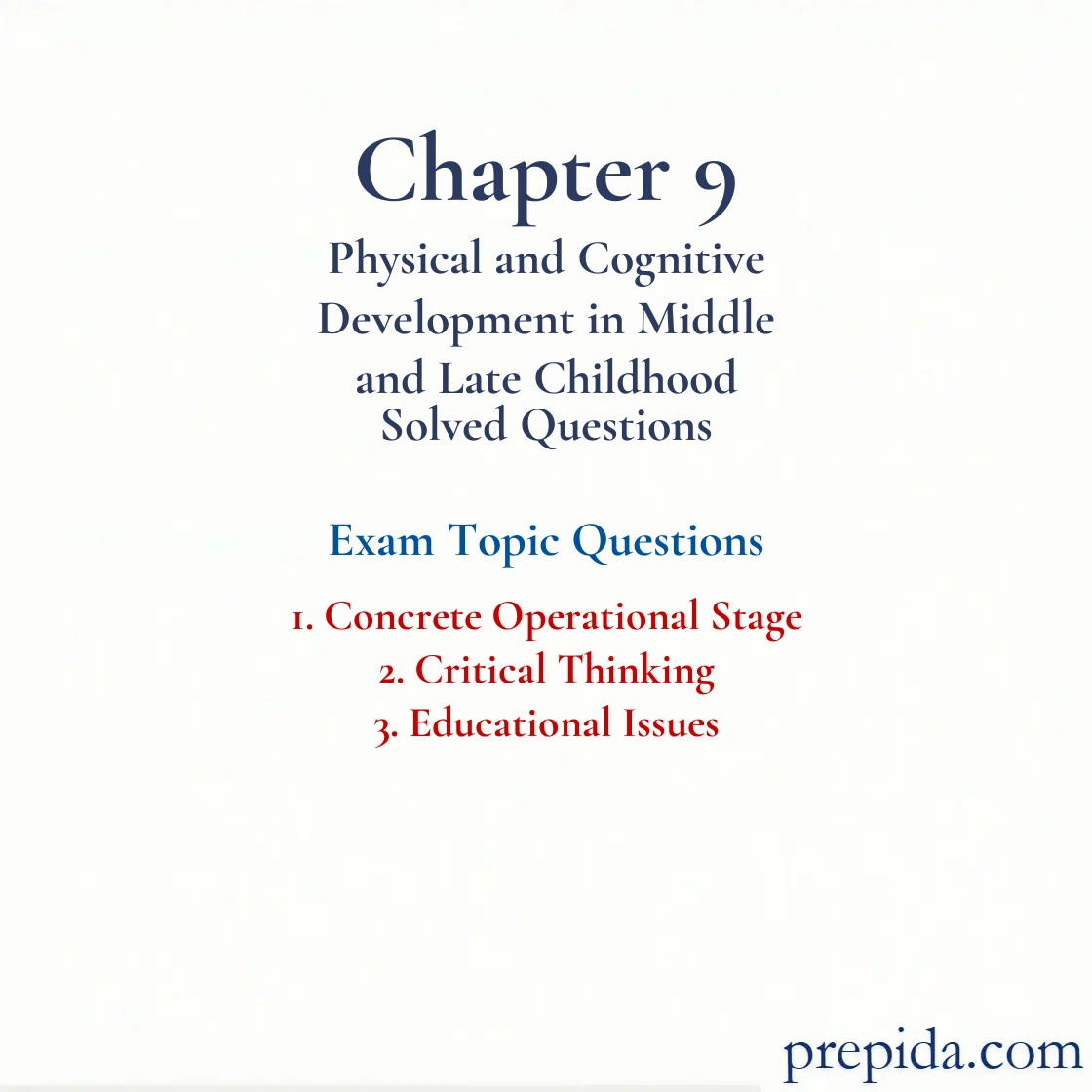
A child is presented with two identical balls of clay. The experimenter rolls one ball into a long, thin shape; the other remains in its original ball form. The child is then asked if there is more clay in the ball or in the long, thin piece of clay. If the child answers the problem correctly but cannot use abstract reasoning yet, the child most likely is in which stage of Piaget's cognitive development theory?
- sensorimotor stage
- preoperational stage
- formal operational stage
- concrete operational stage
Preoperational Stage: Piaget’s second stage, lasting from about 2 to 7 years of age, during which children begin to represent the world with words, images, and drawings, and symbolic thought goes beyond simple connections of sensory information and physical action; stable concepts are formed, mental reasoning emerges, egocentrism is present, and magical beliefs are constructed.
In relation to the cognitive development theory, Piaget proposed that the concrete operational stage lasts from approximately ________ years of age.
- three to five
- five to seven
- seven to eleven
- ten to thirteen
Theory: An interrelated, coherent set of ideas that helps to explain phenomena and facilitate predictions.
Luis is able to organize coins in a row from the largest in size to the smallest. His newfound ability is called
- centration.
- seriation.
- reversibility.
- classification.
Seriation: The concrete operation that involves ordering stimuli along a quantitative dimension (such as length).
Byron can take sticks of different lengths and put them all in order from shortest to longest. He can also discern that if stick A is longer than B and B is longer than C, then A is longer than C. This ability to logically combine relations to understand certain conclusions is
- seriation.
- transitivity.
- transduction.
- classification.
Transitivity: The ability to logically combine relations to understand certain conclusions.
Children who have reached the concrete operational stage are capable of ________, which is the ability to order stimuli along a quantitative dimension, such as length.
- centration
- seriation
- reversibility
- classification
Seriation: The concrete operation that involves ordering stimuli along a quantitative dimension (such as length).
When a person thinks reflectively and productively and evaluates evidence, he or she is engaging in
- critical thinking.
- metacognition.
- cognitive monitoring.
- control processes.
Critical Thinking: Thinking reflectively and productively, as well as evaluating evidence.
Sadie has a learning disability and is being educated in the least restrictive environment possible. This means that Sadie
- is given great freedom and few rules.
- is placed in as regular a classroom as possible.
- has significant input into the development of her educational goals.
- spends part of her time in a regular classroom and part of her time in a special education classroom.
Learning Disability: Difficulty in understanding or using spoken or written language or in doing mathematics. To be classified as a learning disability, the learning problem is not primarily the result of visual, hearing, or motor disabilities; intellectual disability; emotional disorders; or due to environmental, cultural, or economic disadvantage.
Jacob is a third grader and has a disability that has caused him to be separated from his peers during the school day. Recently, Jacob was moved to the regular third-grade classroom. This is an instance of
- transforming.
- transitioning.
- incorporation.
- inclusion.
Inclusion: Educating a child with special requirements full-time in the regular classroom.
The ________ is a setting that is as similar as possible to the one in which children who do not have a disability are educated.
- ideal learning environment (ILE)
- special learning environment (SLE)
- least discriminating environment (LDE)
- least restrictive environment (LRE)
Least Restrictive Environment (LRE): A setting that is as similar as possible to the one in which children who do not have a disability are educated.
A(n) ________ is a written statement that spells out a program that is specifically tailored for a student with a disability.
- tailored education plan (TEP)
- individualized education plan (IEP)
- exclusive education plan (EEP)
- disabilities education plan (DEP)
Individualized Education Plan (IEP): A written statement that spells out a program specifically tailored to a child with a disability.
From the following options, identify the disorder that consists of serious, persistent problems involving relationships, aggression, depression, and fears associated with personal or school matters, as well as other inappropriate socioemotional characteristics. Approximately eight percent of children who have a disability and require an individualized education plan fall into this classification.
- autism
- ADHD
- emotional and behavioral disorders
- learning disorders
Emotional And Behavioral Disorders: Serious, persistent problems that involve relationships, aggression, depression, fears associated with personal or school matters, as well as other inappropriate socioemotional characteristics.
The Education for All Handicapped Children Act, enacted in 1975, required that
- all students with disabilities be brought into mainstream schools.
- parents of children with disabilities provide homeschooling for their children.
- all students with disabilities be given a free, appropriate public education.
- a standard curriculum be provided for students with and without disabilities.
Individualized Education Plan (IEP): A written statement that spells out a program specifically tailored to a child with a disability.